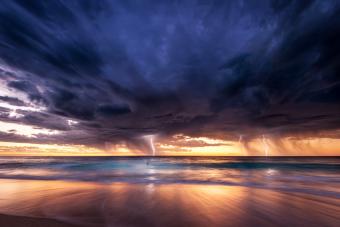
Hurricanes are powerful storms that start in warm ocean waters and create intense winds and huge waves. While these dangerous storms are known to cause a lot of damage, they can be very interesting to learn about. From how they are formed to how they are named, explore these 11 cool facts about hurricanes for kids below.
1. Hurricanes Can Produce Tornadoes
As if the waves and winds aren't bad enough, when a hurricane hits land, it can produce tornadoes. According to Dr. Greg Forbes, 20 percent of tornadoes are caused by hurricanes in the U.S. in the month of August. This can go up to 50 percent in September; however, most of the tornadoes that hurricanes cause are weak and don't last long on land.

2. Hurricanes Lose Power Over Land
One key hurricane fact is that they all need water to thrive. So, when they hit land, they don't have the energy coming from the ocean anymore. This means the hurricane will start to break up and slowly die. So if you live in Nebraska or another land-locked state, there's no need to worry about a hurricane.
3. One of the Worst Hurricanes Happened in 1780
The Great Hurricane happened in 1780 in the Caribbean islands, and it is assumed it made landfall in Barbados. While the point of origin isn't known, it did kill more than 20,000 people, making it one of the deadliest storms in the Atlantic.
4. Hurricanes and Typhoons Are Both Tropical Cyclones
A tropical cyclone is a spinning storm that starts over warm water. A hurricane and a typhoon are different types of tropical cyclones. The only difference between the two is the ocean they start on. For example, hurricanes start over the North Atlantic, Northeast Pacific, and South Pacific Oceans, while typhoons originate over the Northwest Pacific Ocean.
5. The Eye of a Hurricane Is Calm
The entire hurricane revolves around the eye of the storm. This means the winds circle around the eye, so the winds in the eye of the storm are rather calm. When the eye of the storm reaches you, it is kind of like having a small break from the wind.

6. Hurricanes Spin Different Ways Depending on Where You Are
While you might think all hurricanes would spin the same way, this is simply untrue. A fun fact about hurricanes is that they will spin in different directions depending on where they start due to something called the Coriolis effect. Basically, hurricanes in the Southern Hemisphere spin clockwise while those in the Northern Hemisphere spin counterclockwise.
7. Hurricanes Will Spin Around Each Other
Another interesting fact about hurricanes is that when two hurricanes collide, they do not necessarily join together to create a giant storm. If the storms are of similar size and intensity (and are spinning in the same direction), they might just dance around each other before going on their separate ways. This is called the Fujiwhara Effect. However, if one of them is much bigger than the other, it could absorb the smaller one to great a bigger storm.
8. Hurricanes Need Heat and Water to Form
Hurricane seasons are only when the water is warm, and there is a very specific reason for this. Hurricanes need warm ocean water and moist air above the ocean to form. This is why a true tropical cyclone can only occur near the equator.
9. Hurricanes Can Reach Speeds of Over 157 mph
At its most dangerous, a hurricane's wind speed can exceed 157 mph. What you might think of as a normal "breezy day" is likely between 15-20 mph winds, so imagine a storm that is 10 times as windy! This is why hurricanes can cause so much damage to areas of land that they hit.
10. Hurricanes Come in Categories
There are five different categories that hurricanes come in. The type of category they fall into depends on the speed of the winds.
- Category 1: Up to 95 mph
- Category 2: Up to 110 mph
- Category 3: Up to 129 mph
- Category 4: Up to 156 mph
- Category 5: Anything over 157 mph
11. Hurricanes Were Once Named After Real People
Clement Wragge is the meteorologist credited with naming hurricanes, but he got into a little trouble when he started naming bad storms after political figures he didn't like. In the 1940s, it became popular to name storms after important people like wives and girlfriends. Now, they are named from an alphabetized list that alternates men's and women's names.
One of the Most Dangerous Storms
Lists of storm facts for kids like this one will hopefully encourage curiosity about science and the powerful things the planet is capable of. There are a lot of different storms that can occur, but a hurricane is one of the most dangerous. Although they can be very scary, the good news is that hurricanes have become less deadly due to better and earlier warning systems. You can also follow hurricane safety tips to be prepared in case you experience one of these tropical storms.







